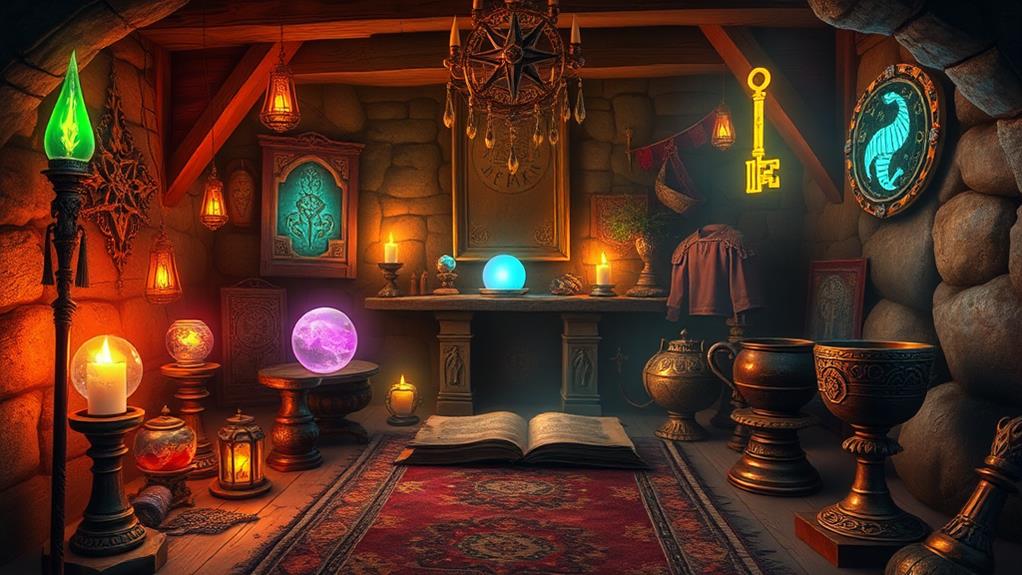
Discover seven rare and powerful relics from the Wizarding World that have left lasting impacts. The Elder Wand, crafted from elder wood and Thestral tail hair, grants unparalleled power. The Resurrection Stone brings forth echoes of the dead. The Cloak of Invisibility offers perfect concealment. The Sword of Gryffindor, goblin-forged, responds to true Gryffindors. The Diadem of Ravenclaw enhances wisdom. The Locket of Slytherin contains dark influences. The Hufflepuff Cup, known for its nurturing enchantments, represents loyalty and patience. Each relic holds a rich history and significant magical properties, waiting to reveal more of their mysteries.
The Elder Wand
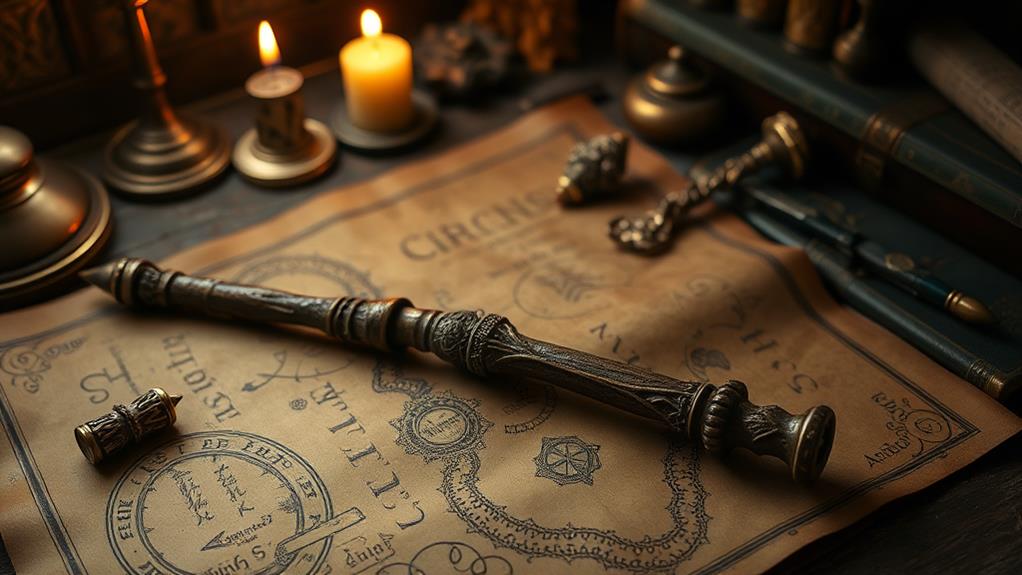
Among the most legendary relics in the Wizarding World, the Elder Wand stands out as a symbol of immense power and intrigue. Crafted from elder wood with a core of Thestral tail hair, this wand is said to be unbeatable in duels. It's part of the fabled Deathly Hallows, a trio of magical objects that grant their possessor mastery over death. The wand has passed through the hands of some of the most powerful wizards and witches, often obtained through violent means.
You might be curious about how the Elder Wand chooses its master. Unlike ordinary wands, it doesn't simply bond with a wizard; it requires that its previous owner be disarmed, defeated, or killed. This makes its history a bloody one, filled with betrayal and conflict.
Despite its allure, the Elder Wand is a double-edged sword. Its immense power attracts those who seek to dominate, but it also brings danger and strife. If you ever come across this wand, remember its history and the toll it has taken on its past masters. It's a relic that symbolizes not just power, but the heavy price that often comes with it.
The Resurrection Stone
One of the most intriguing artifacts in the Wizarding World is the Resurrection Stone. It's not just any magical object; it's one of the three Deathly Hallows. Legend has it that the stone has the power to bring back the dead, though not in the way you might hope. When you use the stone, you can summon the spirits of those who've passed, allowing you to communicate with them. However, these spirits don't return to the world of the living but appear more like echoes of their former selves.
The Resurrection Stone once belonged to Cadmus Peverell, one of the three brothers from the famous "The Tale of the Three Brothers." According to the tale, Cadmus used the stone to bring back his lost love, but her return was bittersweet, filled with longing and sadness. This serves as a cautionary tale about meddling with life and death.
In modern times, the stone was hidden within a ring passed down through generations of the Gaunt family. Eventually, it was discovered by Albus Dumbledore, who recognized its true nature. So, while the Resurrection Stone offers a tantalizing glimpse into the afterlife, it also serves as a somber reminder of the natural order.
The Cloak of Invisibility
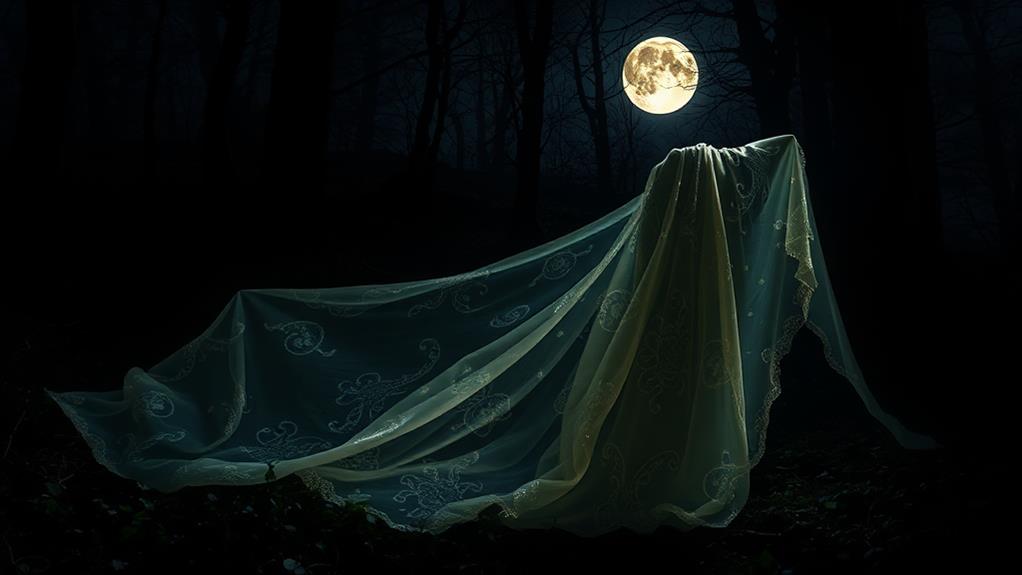
The Cloak of Invisibility, another of the three legendary Deathly Hallows, has fascinated witches and wizards for centuries. Unlike other invisibility cloaks that wear out or lose their magic over time, this cloak remains as effective as the day it was created. When you wear it, you're rendered completely invisible, making it a powerful tool for evasion and secrecy.
Here are some key points about the Cloak of Invisibility:
- History: Passed down through the Peverell family, it eventually came into the possession of Harry Potter, making it an integral part of his journey.
- Unique Properties: Unlike standard invisibility cloaks, this one doesn't degrade and provides perfect concealment without any magical interference.
- Usage: It's been used for various purposes, from sneaking into restricted areas to observing events unnoticed.
- Symbolism: As one of the Deathly Hallows, it symbolizes the acceptance of death, contrasting with the Resurrection Stone and the Elder Wand's quest for mastery over it.
The Sword of Gryffindor
A symbol of bravery and chivalry, Godric Gryffindor's sword stands as one of the most revered relics in the wizarding world. You might recognize this gleaming blade, adorned with rubies, from its many legendary appearances. Forged by goblins, the sword is practically indestructible and possesses unique magical properties. It only presents itself to true Gryffindors in times of need, an endorsement to one's courage and worthiness.
When you grasp the hilt of this sword, you connect with centuries of heroic deeds. It has the remarkable ability to imbibe that which makes it stronger. You'll find it coated with basilisk venom, making it deadly to Horcruxes. This trait was vital when Harry Potter used it to destroy Tom Riddle's diary and other Dark objects.
Don't let its ornate appearance fool you; it's a weapon of immense power. In times of great peril, the sword has appeared to various Gryffindors, including Neville Longbottom, who used it to decapitate Nagini, Voldemort's snake. This act played a pivotal role in the Dark Lord's defeat.
In essence, the Sword of Gryffindor isn't just an artifact; it's a beacon of heroism and resilience.
The Diadem of Ravenclaw
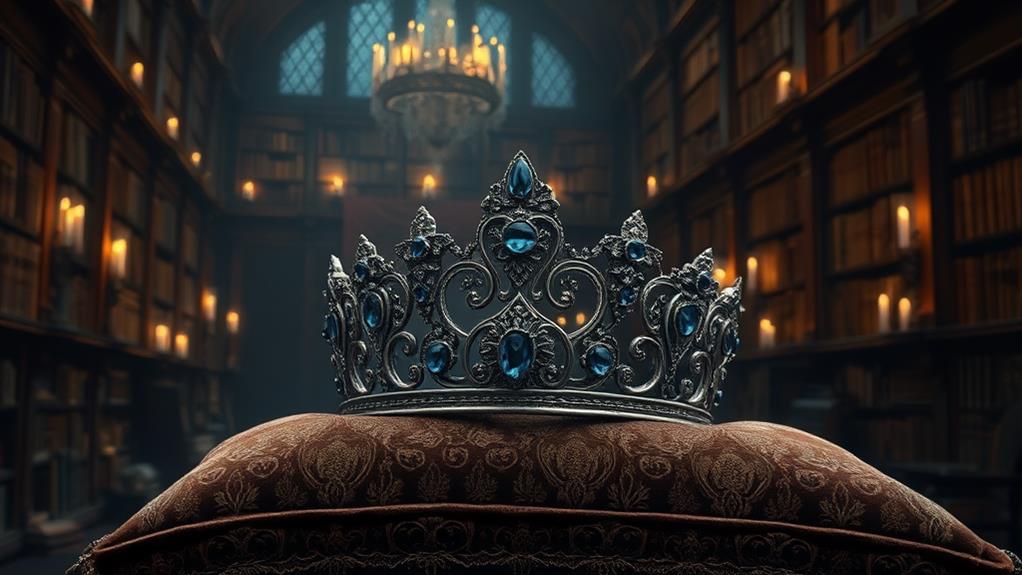
Often shrouded in mystery and intellectual allure, Rowena Ravenclaw's diadem is another esteemed relic of the wizarding world. This artifact is said to enhance the wisdom of its wearer, making it one of the most coveted items in magical history. You might be intrigued to know that its legend is steeped in both historical significance and magical potency.
To better understand the significance of the Diadem of Ravenclaw, consider these key points:
- Creation: Forged by Rowena Ravenclaw herself, the diadem was imbued with enchantments to augment the intelligence of its wearer.
- Disappearance: The diadem was lost for centuries after being hidden by Ravenclaw's daughter, Helena, who stole it in hopes of gaining her mother's wisdom.
- Discovery: Tom Riddle, later known as Lord Voldemort, located and transformed the diadem into one of his Horcruxes, hiding it within Hogwarts.
- Destruction: The diadem met its end in the Room of Requirement, destroyed by a combination of Fiendfyre and the efforts of Harry Potter and his allies.
Understanding these elements helps you appreciate the diadem's profound impact on wizarding history and lore.
The Locket of Slytherin
Salazar Slytherin's locket stands as a dark and powerful relic within the wizarding world. Crafted by one of Hogwarts' founders, it embodies his ambition and pure-blood superiority beliefs. When you first see the locket, its ornate design and emerald-encrusted "S" immediately catch your eye, symbolizing Slytherin's house. It's not just a piece of jewelry; it's imbued with dark magic.
You might remember this locket from its role in the dark events involving Lord Voldemort. He turned it into a Horcrux, hiding a fragment of his soul within it to achieve immortality. This made the locket even more dangerous and malevolent. When worn, it can influence the wearer's emotions, amplifying their darkest thoughts and fears. It's a constant reminder of Slytherin's legacy and Voldemort's dark quest for power.
Retrieving the locket wasn't easy. It was hidden in a cave protected by numerous enchantments and dangerous obstacles. Destroying it required the use of Godric Gryffindor's sword, which had absorbed basilisk venom. When you think about Slytherin's locket, you're reminded of the lengths to which wizards will go to protect their most treasured and dangerous artifacts.
The Hufflepuff Cup
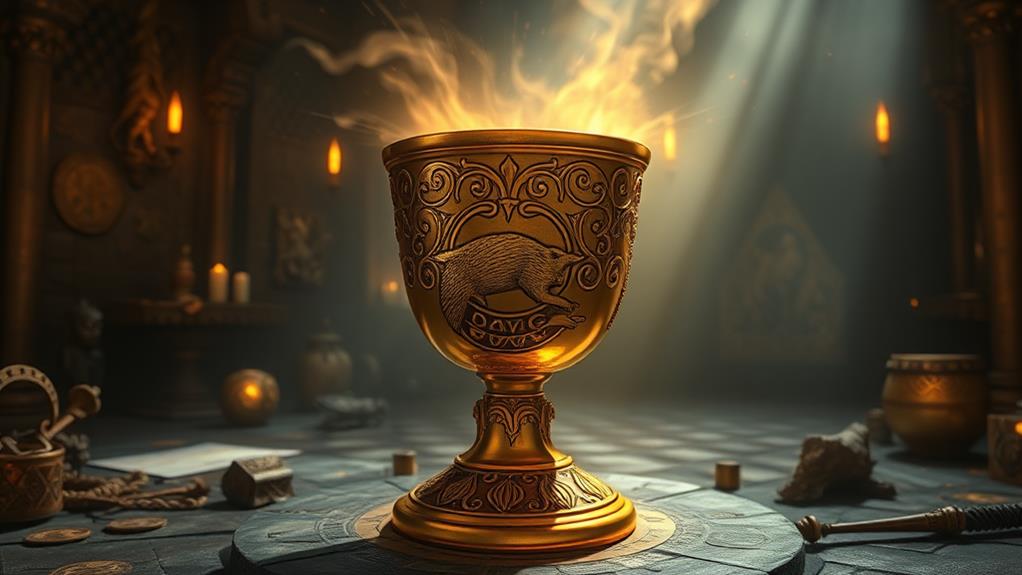
Helga Hufflepuff's cup is another significant relic from the wizarding world's rich history. This small, golden goblet once belonged to one of Hogwarts' founders, Helga Hufflepuff. It's renowned for its enchanting abilities and historical value. As you explore its significance, you'll uncover a few key aspects that make this relic extraordinary.
- Origins: The cup was crafted by Helga Hufflepuff herself, symbolizing her values of loyalty, patience, and hard work. It's said to possess magical properties that can enhance the abilities of its user.
- Ownership: After Helga's time, the cup was passed down through generations of Hufflepuff descendants until it was stolen by Hepzibah Smith, a wealthy witch. Tragically, it later became one of Voldemort's Horcruxes.
- Magical Properties: The cup is believed to have the power to produce food and drink, aligning with Hufflepuff's nurturing nature. Its enchantments, though not fully documented, hint at its potential to aid in healing and sustenance.
- Destruction: Ultimately, the cup was destroyed by Hermione Granger using a basilisk fang during the Battle of Hogwarts, removing one piece of Voldemort's soul.
Understanding the Hufflepuff Cup's journey sheds light on its importance in wizarding lore.
At a Glance
You've just journeyed through the magical tapestry of seven rare wizarding world relics. These artifacts, each with their own rich history and immense power, are the crown jewels of magical lore. From wielding the Elder Wand to uncovering the Cloak of Invisibility, you've glimpsed into a world where legends come alive. Keep this knowledge close, like a spellbook filled with secrets, and let your imagination soar like a phoenix rising from the ashes.






